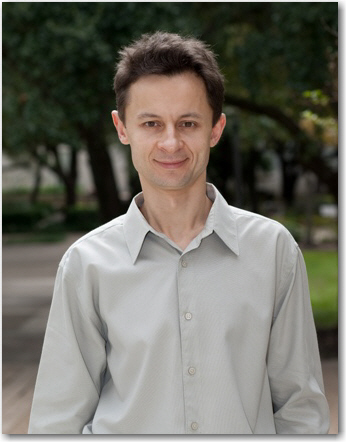UH Chemist Investigates Material for Next-Generation Computer Memory
Vassiliy Lubchenko Receives Prestigious Sloan Research Fellowship

Vassiliy Lubchenko, an assistant professor of chemistry at UH, was recently selected as a 2011 Alfred P. Sloan Research Fellow for his achievements and potential to contribute substantially to his field. Drawn from 54 colleges and universities in the United States and Canada, this year’s 118 fellows are early-career scientists and scholars. Lubchenko is one of four winners in Texas. Each will receive a $50,000 fellowship in support of original research and education in science, technology, engineering, mathematics and economic performance.
As a theoretical physical chemist, Lubchenko takes raw data from researchers in a lab and uses mathematical and computer modeling to explain existing measurements and predict what will occur in future experiments and other systems. Amorphous semiconductors, for example, are something he is studying for their applications in phase-change computer memory, which is a potential successor of flash memory.
“One can control the conductivity and reflectivity of phase-change materials – and hence encode information – by varying the speed of cooling a melted material and forcing it to either crystallize or to form a glassy solid,” Lubchenko said. “Glass transition is one of the most important, yet least understood, branches of modern physical chemistry. Semiconductor glasses exhibit many unique anomalies whose explanation has evaded researchers for decades. My findings show these anomalies are not a generic consequence of disorder, but instead can be traced to how these solids form from the corresponding liquid.”
An important component of his research is to predict the structure and glass-forming ability of specific substances. This task is inaccessible to computer technology, but Lubchenko’s technique applies a combination of analytical theories and computational modeling that singles out the most important aspects of the liquid dynamics and electronic motions that precede the glass transition and are amenable to mathematical treatment.
Another area of Lubchenko’s research involves protein aggregation, a process thought to be responsible for many degenerative diseases, such as sickle cell anemia or Alzheimer’s. His work may make it easier to make protein crystals, which could help in the treatment of such diseases.
“Vas’ Sloan award, his third Tier One award since 2008, is recognition by his peers that he tackles and solves tough research problems,” said David Hoffman, professor and chair of the chemistry department in the College of Natural Sciences and Mathematics at UH. “We are very proud of his accomplishments and feel fortunate to have him as a colleague.”
A Ukrainian native, Lubchenko is a graduate of the Moscow Institute of Physics and Technology. He received his Ph.D. from the University of Illinois at Urbana-Champaign and was a postdoctoral research fellow at the Massachusetts Institute of Technology before coming to UH in 2005. In addition to the Sloan fellowship, Lubchenko received the Beckman Young Investigator Award in 2008 and the NSF CAREER award in 2010.
For more information about the Alfred P. Sloan Foundation, visit http://www.sloan.org/.
- Lisa Merkl, University Communication